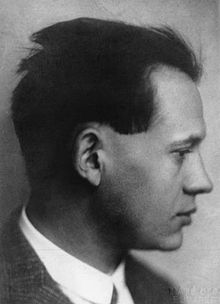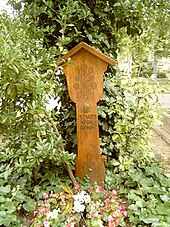László Lajtha
László Lajtha [ ˈlaːsloː ˈlɒjtɒ ] (born June 30, 1892 in Budapest , Austria-Hungary ; † February 16, 1963 ibid) was a Hungarian composer .
Life
László Lajtha first studied at the Budapest Music Academy with Victor von Herzfeld and also politics at the University of Budapest (graduated in 1913). He continued his music studies in Leipzig and Geneva and studied for six months in Paris with Vincent d'Indy from 1911 to 1913 . There he came into contact with Maurice Ravel and Florent Schmitt, among others . In the second decade of the 20th century he began collecting Hungarian folk music and concentrated on the regions that Béla Bartók and Zoltán Kodály had not covered. From 1913 Lajtha worked in the folk music department of the Hungarian National Museum . During the First World War he was an artillery officer at the front. From 1919 he taught composition and chamber music at the National Conservatory in Budapest . He first found greater international recognition as a composer in 1929 when he was awarded the Coolidge Prize for his 3rd string quartet.
After the Second World War , Lajtha became music director of the Hungarian radio and at the same time director of the Ethnographic Museum and the Budapest National Conservatory. He spent 1947 in London to compose the score for Murder in the Cathedral (based on TS Eliot ). For political reasons he lost all public offices on his return to Hungary. In 1951 he received the Kossuth Prize for his services to folk music. In 1952 he became a professor of folk music research at the Budapest Academy of Music.
Lajtha was the first composer since Franz Liszt to be elected a corresponding member of the French Académie des Beaux-Arts . Because of his opposition to the communist regime, his music was hardly played in his own country for a long time. Since his passport had been withdrawn for several years and so trips abroad were impossible, he could hardly stand up for his works even outside of Hungary. This contributed significantly to the fact that Lajtha's level of fame does not match the quality of his music to this day.
plant
With his 9 symphonies (composed between 1936 and 1961) and a few other works of a symphonic character, Lajtha is considered the first important Hungarian symphonic composer. He also wrote the comic opera Le chapeau bleu (1948–50), a violin concerto (1931) and 10 string quartets.
In Lajtha's music, Hungarian-tinged themes are combined with French-influenced, impressionistic harmony and instrumentation, as well as motor rhythm. Neoclassical elements are also taken up in later works .
Individual evidence
- ↑ Murder in the Cathedral (1951) in the Internet Movie Database (English)
literature
- Alfred Baumgartner: Music of the 20th Century . Kiesel Verlag, 1983, ISBN 3-7023-4005-X , pp. 327-328
- CD supplement Marco Polo 8.223669, L. Lajtha: Symphony No. 2 u. a., Pécs SO, Nicolàs Pasquet, 1995 (English-language text by Emöke Solymosi Tari)
Web links
- Works by and about László Lajtha in the catalog of the German National Library
- László Lajtha in the Internet Movie Database (English)
| personal data | |
|---|---|
| SURNAME | Lajtha, László |
| BRIEF DESCRIPTION | Hungarian composer |
| DATE OF BIRTH | June 30, 1892 |
| PLACE OF BIRTH | Budapest , Austria-Hungary |
| DATE OF DEATH | February 16, 1963 |
| Place of death | Budapest , Hungary |

